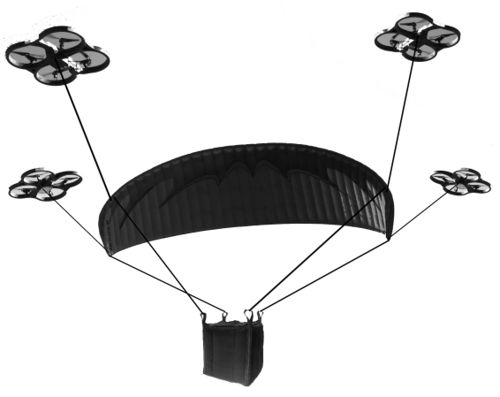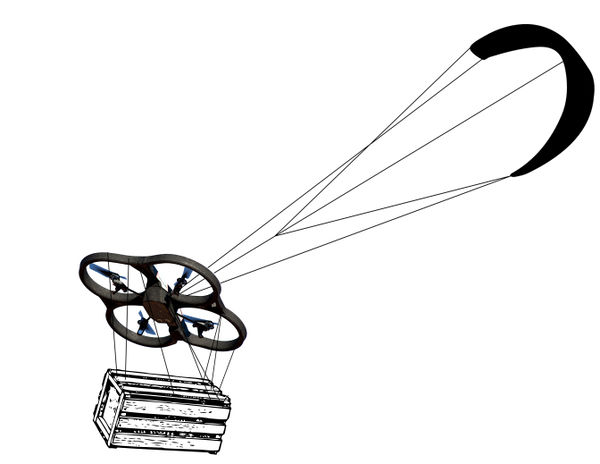DroneKite: Difference between revisions
Jump to navigation
Jump to search

m (couple of minor edits) |
|||
| Line 1: | Line 1: | ||
[[File:DroneKite.jpg|600px|thumb|right|DroneKite concept.]] | [[File:DroneKite.jpg|600px|thumb|right|Basic idea of DroneKite but not a concept. Combination of drone, ]] | ||
Idea to combine an aerial drone with a dispatchable kite for long-distance, low-energy transport. You read it here first - this has never been previously proposed anywhere. The drone with cargo takes off from the ground | Idea to combine an aerial drone with a dispatchable kite for long-distance, low-energy transport. You read it here first - this has never been previously proposed anywhere. The drone with cargo takes off from the ground or tower. It then releases the kite once it reaches a certain altitude. The high-altitude wind then allows for long-distance sailing, possibly over thousands of kilometers. Near the landing destination, the drone motors take over again and navigate the vehicle safely to the ground. The kite can then be stowed for the next deployment. | ||
*Relies on accurate weather prediction | * Relies on accurate weather prediction | ||
*Bag for cargo (e.g. [https://en.wikipedia.org/wiki/Flexible_intermediate_bulk_container Flexible | * Bag for cargo (e.g. [https://en.wikipedia.org/wiki/Flexible_intermediate_bulk_container Flexible Intermediate Bulk Container (FIBC), i.e. "bulk bag"]). | ||
*Especially suitable for cargo made up with powdery consistency (examples: powdered chemicals, flour, animal feeds, up to cereals). This is important safety feature, as the cargo can be dumped before a potential crash in case of loss of control or other failure. | * Especially suitable for cargo made up with powdery consistency (examples: powdered chemicals, flour, animal feeds, up to cereals). This is important safety feature, as the cargo can be dumped before a potential crash in case of loss of control or other failure. | ||
*Can pick up new cargo and deliver it to yet another destination, eventually making its way around the world with the jet stream. | * Can pick up new cargo and deliver it to yet another destination, eventually making its way around the world with the jet stream. | ||
*Batteries can recharge on drag at high altitude | * Batteries can recharge on drag at high altitude, just requiring some velocity differential. | ||
*May need to have more than one drone component for proper navigation. This is also a safety feature: in case one drone fails, the other one is still available to perform an emergency landing. | * May need to have more than one drone component for proper navigation. This is also a safety feature: in case one drone fails, the other one is still available to perform an emergency landing. | ||
*DroneKite may need to be launched from a tower with its kite already deployed. This could allow for less powerful motors and hence lighter weight. | * DroneKite may need to be launched from a tower with its kite already deployed. This could allow for less powerful motors and hence lighter weight. | ||
* implementation as a glider (sailplane) that is launched with a winch from the ground and then deploys the kite at altitude | * implementation as a glider (sailplane) that is launched with a winch from the ground and then deploys the kite at altitude; alternative design as sailplane with retractable wings | ||
* possible application: airborne seeding (e.g. for reforestation using [http://opensourceecology.org/wiki/Seed_balls seed balls]) or for planting | |||
==Design Sketches== | ==Design Sketches== | ||
[[File:DroneKite01.jpg|500px|thumb|left|Concept with four drones for better navigation and power. Once in the air, the drones retract closer to the kite but still help with navigating. The cargo is contained in an FIBC as a safety feature (see above).]] | [[File:DroneKite01.jpg|500px|thumb|left|Concept with [https://en.wikipedia.org/wiki/Foil_kite foil kite] and four drones for better navigation and power. Once in the air, the drones retract closer to the kite but still help with navigating. The cargo is contained in an FIBC as a safety feature (see above).]] | ||
[[Category:Transport]] | [[Category:Transport]] | ||
Revision as of 20:17, 1 July 2016
Idea to combine an aerial drone with a dispatchable kite for long-distance, low-energy transport. You read it here first - this has never been previously proposed anywhere. The drone with cargo takes off from the ground or tower. It then releases the kite once it reaches a certain altitude. The high-altitude wind then allows for long-distance sailing, possibly over thousands of kilometers. Near the landing destination, the drone motors take over again and navigate the vehicle safely to the ground. The kite can then be stowed for the next deployment.
- Relies on accurate weather prediction
- Bag for cargo (e.g. Flexible Intermediate Bulk Container (FIBC), i.e. "bulk bag").
- Especially suitable for cargo made up with powdery consistency (examples: powdered chemicals, flour, animal feeds, up to cereals). This is important safety feature, as the cargo can be dumped before a potential crash in case of loss of control or other failure.
- Can pick up new cargo and deliver it to yet another destination, eventually making its way around the world with the jet stream.
- Batteries can recharge on drag at high altitude, just requiring some velocity differential.
- May need to have more than one drone component for proper navigation. This is also a safety feature: in case one drone fails, the other one is still available to perform an emergency landing.
- DroneKite may need to be launched from a tower with its kite already deployed. This could allow for less powerful motors and hence lighter weight.
- implementation as a glider (sailplane) that is launched with a winch from the ground and then deploys the kite at altitude; alternative design as sailplane with retractable wings
- possible application: airborne seeding (e.g. for reforestation using seed balls) or for planting
Design Sketches

Concept with foil kite and four drones for better navigation and power. Once in the air, the drones retract closer to the kite but still help with navigating. The cargo is contained in an FIBC as a safety feature (see above).
